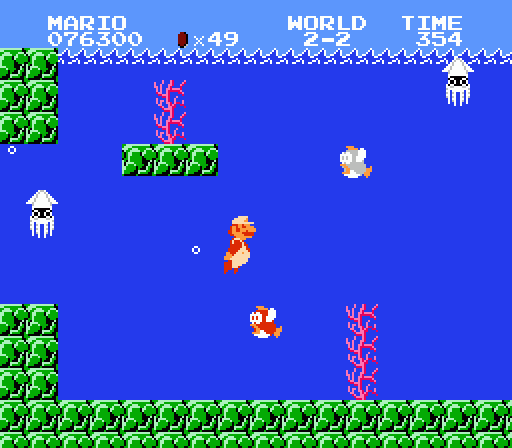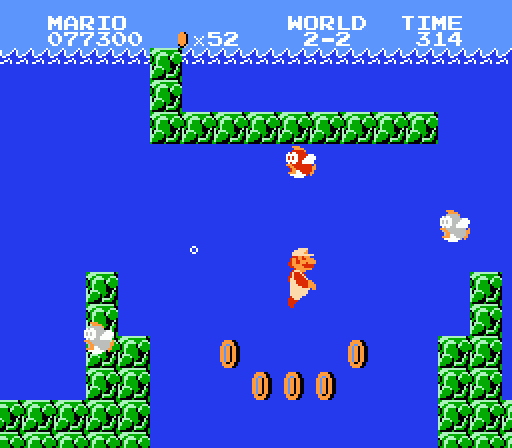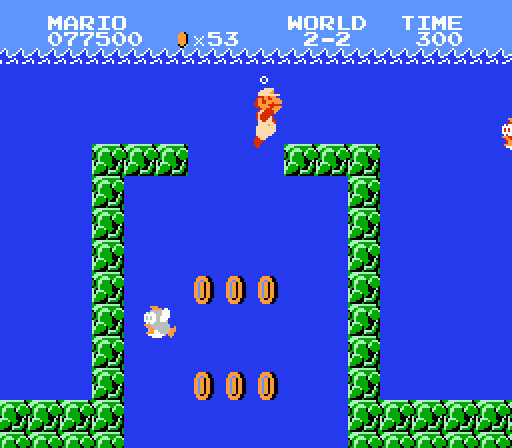Lest you think Super Mario Bros. will be content to simply cycle through variants on the first four stages over and over again until you reach the end, World 2-2 demonstrates that this is not the case at all. Yeah, it begins with a little cutscene of Mario leaving a fortress and taking a pipe underground, but that’s about where the similarities to World 1-2 end. Beyond the pipe waits not another underground tunnel but rather a lake.

This brings a significant new game mechanic into play: Swimming. World 2-2 completely changes the way you control Mario. I mean, sure, you can walk along the bottom of the lake, but you don’t jump. Pressing the jump button instead causes Mario to paddle, pushing himself upward. Constant gravity pulls at Mario at all times underwater, making it impossible for you to remain at a steady level. He’s constantly sinking, and paddling up causes him to counteract that irresistible force.
The frequency with which you paddle determines how you tread the water — infrequently enough, you simply slow your descent. Faster and you’ll remain at roughly the same level, bobbing slightly as you dip and rise. Pump the jump button and Mario will quickly ascend to the surface.
That’s not the only way in which Mario comes across as restless in this stage, though. Inertia works differently underwater, with forward motion not eventually diminishing into rest if you let up on the D-pad. Instead, you’ll continue drifting forward through the water at whatever velocity you initiate for yourself. If you inch forward, Mario will go right on inching until you push the opposite direction; if you go full guns, he’ll keep up that pace for as long as you let him.
The weightlessness and frictionlessness of water in Super Mario Bros. demands a different sort of play discipline. Enemies constantly surround you in all directions, rather than marching along the ground, and much of the challenge underwater consists of propelling yourself forward and keeping Mario afloat without bobbing into a fish. The lack of jump physics beneath the sea means you can’t stomp a foe, after all, so there’s no safe way to tackle a foe.
By and large, the fish — Cheep-Cheeps, presumably named so because they look weirdly chicken-like — are fairly harmless. Unlike in later games, none of them home in on Mario. Instead, they swim ahead in a more or less straight line with a tiny lateral variance, their speed dependent on their coloration. Very simple and generally harmless.
The real hazard comes from the Bloobers, the white squid that dart through the water quickly and somewhat unpredictably. These are the first foes in the game that don’t follow a steady, consistent pattern; they’re beholden to physics similar to Mario’s, constantly drifting downward and zipping upward against the pull of gravity as they advance. They tend to move at roughly 45-degree angles in spastic bursts, generally homing in on Mario’s position. They’d be difficult enemies under any circumstance, but they’re especially tricky underwater, and the threat they represent tends to cause players to get sloppy in their efforts to dodge them. You won’t bump into a Cheep-Cheep under normal circumstances, but when a Bloober is bearing down on you and you’re paddling like mad to get through a narrow passage and to safety? Suddenly those lazy fish become a real threat.
World 2-2 doesn’t feature many complex structures or hazards. It’s really more about getting a handle on this odd new way of controlling Mario, with only a few unusual spots (like this coin “pit”) to challenge you to move with greater precision. Platforms do play a different role here than usual; rather than providing a means to avoid ground-based danger or a way to access higher areas, they instead prove to be obstructions. Mario will bump his head and lose momentum if he swims into a platform, so parallel rows of bricks make the going more difficult.
Of course, there is one possible way to mitigate the challenge of the water stages: Carrying in a Fire Flower. Mario can’t jump on enemies, but he can certainly blast them. Don’t ask about the logic of fire sizzling along underwater, just revel in the fact that you aren’t completely defenseless. Fireballs are especially helpful against Bloobers, since the angle at which you throw fire and the angle at which the squid move tends to be about the same; they’ll often dart right into your attack. Fools!
All told, 2-2 turns out to be pretty short. It’s more or less a tutorial stage, similar to Worlds 1-1 through 1-4, and its modest hazards serve as a gentle introduction to a new type of action.
Interestingly, Mario doesn’t have to worry about drowning. I assume he can simply hold his breath for 400 seconds, like the Olympic champion he is. See, for once that timer in the upper-right corner actually makes sense!



Oh, God, it’s a water level.
The ur-water level, really.
Really not sure how these levels are generally perceived by fans. Or in other words: does everyone else hate these levels as much as I do?
Does anyone like swimming levels in platformers at all? I honestly can’t think of a good example of one. Just last night I popped in Rayman Origins to work on collecting some more doo-dads and knick-knacks, came to a swimming level, and then remembered why I hadn’t played it in months.
Thinking about this today, other developers might have turned this gameplay-mechanic into a game of its own.
@Thomas Nickel
Ecco the Dolphin springs to mind.
Actually no, on further thought it was just the NAME ‘Ecco’ that sprang to my mind, while what I was visualizing was actually the gameplay of the early levels of E.V.O.: Search for Eden. Doh!
This is the kind of esoterica that only a hopeless Nintendo nerd like myself would wonder about, but does anyone exactly when the official name for bloobers was changed to blooper?
Paper Mario, apparently.
That damned suction! Nintendo thought through the play mechanics of the water levels more than most companies did until the 16-bit era.
Not seeing a reply button for some reason, but in response to Stuart:
While I trust that Jeremy’s probably right that the “Blooper” name wasn’t used in-game prior to Paper Mario, Nintendo Power was using it at least as far back as its SMB3 coverage. I remember thinking that was pretty weird.
I loved the water levels, if only for the music (they were horrible without fireballs, though).